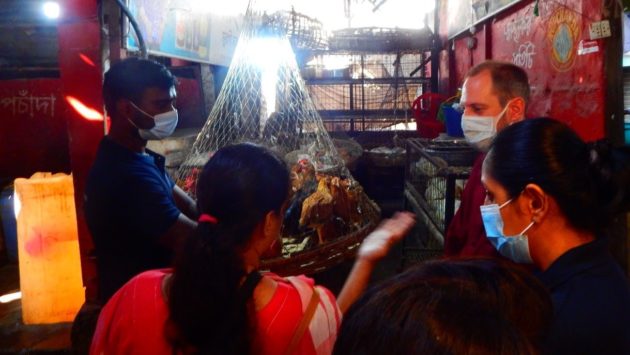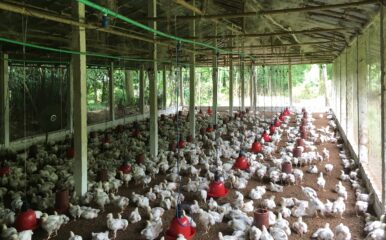
Putting the ‘social’ back into social science
Published on 15/11/2022

Anne Conan
Researchers involved in the Hub’s ethnographic research stream came together for a market visit and one-day workshop in Dhaka, Bangladesh, taking advantage of being in the same city at the same time to observe, share, learn and reflect together.

We were all in Dhaka for the 3rd Hub conference – the first all-Hub in-person event since COVID-19 restrictions and GCRF budget cuts. Thus it was the first time since the inception of the Hub’s ethnographic research stream in late 2020 that social science researchers from across our four case study countries met in person.
There is no substitute for meeting in person and, after more than two years of online coordination, finally getting to do so felt like lifting our collaborations to a new level.
Live bird market
We started our visit to a live bird market early on a Friday. Friday mornings are the busiest times in Dhaka’s live bird markets, while Friday afternoons are the quietest with many shops closing. We started early thus to see a live bird market in full stock and swing, but still a little ahead of the swell of shoppers around mid-morning.
We split ourselves into three groups of six so as not to be an impediment to movement and trade in the narrow market lanes. In this way, we passed displays of mutton and beef and moved into the area with the distinctive bamboo baskets of Dhaka’s live bird markets over which nets hold dozens of chickens in place. We observed birds chosen, throats cut and feathers plucked with speed and confidence across a range of stalls clustered in the narrow alleys we weaved through.

For participants, the sights (and smells!) of this excursion brought the differences of how chicken meat is sold to consumers in cities across the region into stark contrast. This was an important experience allowing everyone to remember that the sale of birds they see in their country is not a global norm, but an activity specific to each place, culture and community in which it takes place. Whether in relatively nearby Chattogram or further afield in Chennai or Colombo, the places and practices of selling chickens and their meat is never quite the same.
While in Bangladesh’s cities, chicken sales mostly involve live bird stalls clustered in sections of markets, in Chennai chickens are more commonly sold through live bird shops scattered throughout the city and its neighbourhoods. Such shops exist in Bangladesh’s cities too but they are usually significantly more expensive – more often used to quickly grab some chicken to cook for unannounced visitors than to do one’s regular purchase.
In contrast, in Colombo and elsewhere in Sri Lanka, birds are already slaughtered when customers choose their cuts of fresh or frozen chicken from shops, rather than markets. The ‘dirty work’ of slaughter, so prominent within Bangladesh’s markets, is less common there.
Research approaches
Our market visit was followed by reflections and discussion about our observations and comparisons. We discussed ethnography as a research process and participants presented their experiences of conducting ethnographic and qualitative social science research.

A diverse array of research processes on chicken production, trade and retail is underway across the Hub sites. It is conducted by researchers of different disciplinary backgrounds and through varied qualitative research approaches – and it ranges from research through (semi-)structured interviews to fieldwork that includes varying degrees of observation. Sometimes it relies on more ethnographic style research, involving the continuous building of rapport with people whose practices in poultry production and trade we seek to understand in detail.
Qualitative social science
The workshop enabled researchers from different sites to present and discuss their approaches , including the challenges and learnings in the process. It provided a space to hear and learn about the experience and practicalities of different approaches to qualitative social science, including ethnography.
In-depth qualitative research does not offer itself to be streamlined and standardised as is required by design in much of the quantitative sciences – especially given the different configurations and kinds of roles involved in poultry production and marketing systems across the Hub sites. There is much to be gained, however, from jointly reflecting on approaches, experiences and insights from research. This both fosters our collaborative network as much as it can inform our evolving research approaches of bringing qualitative social sciences and ethnography into interdisciplinary collaborations with veterinary sciences, epidemiology and One Health more broadly.
Ethnographic research depends on ‘being there’ and interacting directly with the people whose practices we seek to understand. We build rapport and trusted relationships with them, spending time with them to gain a better grasp of their lives and worlds. Rather than simply recording information elicited through an interview or survey, we look for cues and context to inform our interpretation of what people do, how and why they do what they do, and how this is situated in the wider context of their social relations.
As with the requirement of ‘being there’, in-person collaboration is important for building effective partnerships. The depth of communication and mutual understanding facilitated by working together face-to-face cannot be matched by emails or teleconferences alone. Our recent workshop and joint field visit in Dhaka were a great reminder of this.


